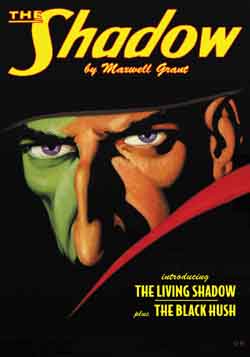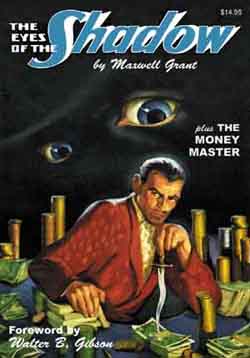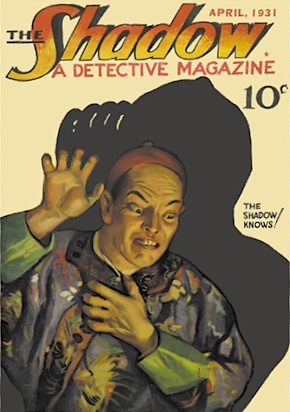 |
| Vol. 49 |
This is the third-ever Shadow novel. Celebrating the eightieth anniversary year of the Shadow's first appearance in print, the Sanctum Press “double-novel” reprint series has now completed republication of the first three pulp novels in order as the first story in volumes 47, 48, and 49 respectively. And I have read those three stories – The Living Shadow, Eyes of the Shadow, and now The Shadow Laughs – in order over the past three months. I began my current immersion in the world of pulp fiction a few months ago with a couple of the later-written novels, but when the publisher announced the release of the original “trilogy” (only in the sense that it's three stories – there's little connection between what are really just the first three of over three hundred stories) I determined to read these as they became available.
 |
| Vol. 47, containing the first Shadow story |
As of this third offering, obviously some kinks were still being ironed out, but from the beginning the familiar elements that would be part of the saga were all there – the mysterious black-cloaked figure himself, his blazing .45s, his band of aides and allies none of whom know his identity, the fear that he inspires in the criminal underworld, and so forth. Of course, not all the aides and allies are here yet – more would be added in the future – but these three stories have introduced Harry Vincent (in the very first scene of The Living Shadow), Claude Fellows, Burbank (did he ever get a first name?), and Vic Marquette. The Shadow's “true identity” of Lamont Cranston made its first appearance in the second book – then we find that it's not really his “true identity” but rather a ruse in this third book when we meet the real Lamont Cranston – who finds his identity basically stolen by this mysterious figure. (He goes along with it at first because he basically has to; later he too would become a willing ally of The Shadow. And we would ultimately find out The Shadow's real true identity … or would we...?) The familiar girasol ring, the slouch hat, the master of disguise – that's all here. But since this is early, there are some jarring notes as well – such as reference in this third story to The Shadow's black silk mask – which I don't think ever appeared again.
 |
| Vol. 48, containing the second Shadow story |
It's an oft-told story how The Shadow Magazine came to be. First there was the radio program – simply an anthology show in which various short radio plays were introduced by a mysterious voice calling itself “The Shadow.” The stories were said to be based on stories in Street and Smith's Detective Story Magazine. But then newstands reported a surge of people coming and wanting to read “that 'Shadow' magazine” – so Street and Smith hastily put out such a title to meet that demand. It quickly went from quarterly to monthly to ultimately twice-a-month publication as it would remain for most of its long run. Luckily Walter Gibson was an amazingly fast writer – he was able to keep up the pace for the most part, writing almost three hundred of the stories that were published over almost twenty years. Only a handful of stories would come from the typewriters of others. The Shadow as a pulp-literary figure came first – The Shadow as a radio hero himself in his own adventures as opposed to his original role as simply the host would come only later.
Interestingly, just as he professed (under the pen name of “Maxwell Grant”) to simply be recording stories as told to him “from the Private Annals of The Shadow” (on the title page of each adventure), Gibson also included the radio show element of the hero's origin into his stories from the beginning. In the radio studio there exists a small room with a hidden access, from which The Shadow would play his role as described above – and in so doing pass coded messages to his aides! No one ever saw him enter or leave that room. Nevertheless, unlike the radio-version that would ultimately follow (and would indeed be written by Gibson himself), The Shadow of the pulps had no supernatural powers beyond great intelligence, physical prowess, speed, and the black garb that allowed him to seem to melt into any available pool of shadow – no mysterious Eastern ability “to cloud men's minds” and literally become invisible. I've heard a number of the radio shows and they're good. The literary Shadow is better.
The Shadow's cultural significance cannot be overstated. “Who knows what evil lurks in the hearts of men?” Those who've neither heard a radio show nor read a pulp novel know that “The Shadow knows! Hahahahahah....!” The appearance of The Shadow Magazine and its quick popularity pretty much gave birth to the explosion of hero pulps during the early 1930s – his own fellow Street and Smith character Doc Savage, rival Popular Publication's The Spider, and too many more to list. In a way, the pulps begat comic books – and in a forthcoming post I'll write about how The Shadow begat The Batman. He is truly an icon.
The plot of this third story, in a nutshell: A counterfeiting plot gives rise to murder – including that of a police detective – putting both The Shadow and his agents and Secret Service Agent Vic Marquette onto the chase. Harry Vincent is assigned to guard the brother of the supposed killer, bringing him into the midst of a group of suspicious men among whom he must discern who is part of the plot, while The Shadow scours the city for the real murderer and his cohorts. And it turns out the mastermind is an old foe of The Shadow, from the previous adventure. Plot twists abound before it all comes together in a blaze of gunfire in the end. It's great stuff!
Since this is the first of the Shadow volumes I'm blogging about, I want to say a couple words about the presentation. Even though they are from separate publishers, The Shadow reprint series and The Spider reprint series are superficially similar in format. Both include two stories together under one cover – both doing so not in original publication order (that's a drawback – why not republish them ino order?). They are pretty much the same dimensions and thickness. Both reset the type for easier reading, but otherwise closely follow the page format of the original pulp magazines, including the interior line illustrations as far as I can tell in their appropriate locations. Both use the cover painting from one of the original stories for the front cover, while reproducing the actual covers for both as thumbnails on the back cover. However, The Shadow series has a couple of features over the other. First, maybe not always, but at least sometimes the stories are paired together with purpose, while The Spider stories seem truly to be thrown together at random.
 |
| The Shadow Magazine #1 |
That's not really apparent with this current volume 49, but for instance volume 47's stories were chosen so as to be able to use as the cover the iconic image of The Shadow from the 1 August 1933 issue (The Black Hush) rather than the actual cover - to save money they re-used a cover from an old issue of another magazine! (Yes, there is a Chinese character in the first Shadow adventure, and he casts a shadow on the cover, but it's not The Shadow!) One volume of The Shadow reprints has two stories that take the hero out of his normal haunts, across the sea to Great Britain: Vol. 8, The London Crimes and Castle of Doom. Another – the next that I'll blog about – contains two stories that each directly contributed elements to the creation of Batman (along with another non-Shadow story that also played a hand, so to speak). Secondly, each volume contains several text pages of commentary generally by series editor Anthony Tollin as well as pulp historian Will Murray (and sometimes others – for instance, “the Batman volume” has an introduction by Jerry Robinson, the man who created The Joker and drew many of the Batman's early exploits). Girasol Publication's The Spider reprint series has no such commentary – just the stories themselves, which are great to be sure, but it's always nice to get a little discussion and context.
Cheers!

No comments:
Post a Comment